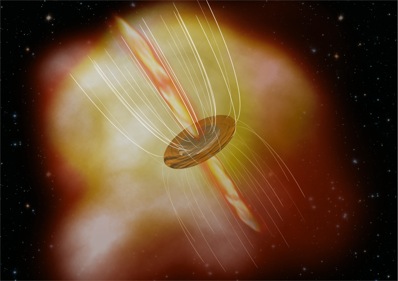


|

|
 |
|
Alcohol masers reveal massive stars’ magnetic birth KEITH COOPER ASTRONOMY NOW Posted: 19 February 2010 Powerful magnetic fields play a much more dominant role in the creation of massive stars than they had been given credit, confirming that giant stars and smaller dwarf stars like our Sun form in very similar ways.  Artist’s impression of Cepheus A HW2, showing a narrow jet blasting out from the poles of the protostar, surrounded by a close dust disc and a wider disc of gas. The white lines indicate the structure of the magnetic field. Gas from the disc uses these field lines as pathways to accrete onto the young protostar. Image: Tobias Maercker. Artist’s impression of Cepheus A HW2, showing a narrow jet blasting out from the poles of the protostar, surrounded by a close dust disc and a wider disc of gas. The white lines indicate the structure of the magnetic field. Gas from the disc uses these field lines as pathways to accrete onto the young protostar. Image: Tobias Maercker.
This is the conclusion of new radio observations using the MERLIN (Multi-Element Radio-Linked Interferometer Network) radio telescope array that is centred on Jodrell Bank in Cheshire and also has telescopes across the English countryside in Cambridge, Defford, Knockin, Darnhall and Pickmere. Making use of a powerful upgrade to the MERLIN network, called e-MERLIN, a team led by Dr Wouter Vlemmings of Bonn University in Germany observed the young protostar Cepheus A HW2, which is located in the Cepheus A star-forming region 2,300 light years away. With the increased sensitivity of e-MERLIN, they were able to map radio waves emanating from methanol masers covering an area ten times the size of the Solar System around the young, massive star. Masers are basically microwave versions of lasers, but can occur naturally wherein microwaves are amplified by molecules, in this case the simple alcoholic compound methanol. The radio data revealed that magnetic fields direct the gas from the surrounding disc down field lines and onto the growing star, allowing it to gather mass. The magnetic fields also act as feedback mechanisms, driving jets of matter from the poles of protostars and out into interstellar space. Such jets are common in small protostars where magnetic fields reign, but have also previously been seen in protostars ten times the mass of the Sun by the Gemini North telescope on Mauna Kea in Hawaii (see our related news story here) “While magnetic fields have been observed in the clouds of molecular hydrogen from which stars form, observations close to massive stars have up to now been in short supply,” says Vlemmings. “Our new technique allows us for the first time to measure the 3D structure of the magnetic field around a massive protostar,” adds team-member Huib Jan van Langevelde Director of the Joint Institute for Very Long Baseline Interferometry in Europe (JIVE). “We can see that its structure is surprisingly similar to how we think the field looks when much smaller stars form.” The findings, published in the Monthly Notices of the Royal Astronomical Society, neatly tie in with previous observations of embryonic massive stars in the Orion Nebula using the Very Long Baseline Array in the United States (see related story here). In that study, astronomers had observed masers produced by silicon monoxide molecules in the gas cloud, and watched the masers follow an arcing path as though they were moving along magnetic field lines. “Magnetic fields are supposed to be weak and unimportant to the birth process for massive stars, but masers would not travel along gentle arcs unless they experience some sort of force, probably a magnetic force,” said lead researcher Lynn Matthews at the time. Now it seems her suspicions have been confirmed. |
|
|
|
|